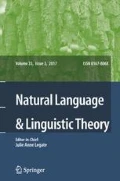Abstract
Agreement with coordination has been a topic of much discussion in the syntactic literature for decades. This is due to its significance in deepening our understanding of key issues, such as the way primitive syntactic operations such as Merge and Agree operate and interact with hierarchical/linear distance, the location of agreement in the grammar, and whether or not narrow syntax, just like the PF, has access to linear order when valuing agreement. This paper empirically and theoretically contributes to the growing body of literature on the topic by investigating agreement with preverbal and sandwiched coordinate phrases in Jordanian Arabic. A special focus will be directed to furthest conjunct agreement, agreement with the first conjunct in preverbal position, since it challenges the mainstream generalization that conjunct agreement occurs with the closest conjunct. The paper reports on a series of four large-scale experiments on Jordanian Arabic and shows that agreement in these domains comes in various forms. Building on Citko (2018), I propose an analysis of the facts that overcomes the problems faced by previous work and that provides support to a new perspective on the computation of agreement, by distinguishing multiple simultaneous Agree that gives rise to resolved agreement from multiple nonsimultaneous Agree, where agreement may be distributed between narrow syntax and the PF.
Similar content being viewed by others
Notes
The following abbreviations will be used in the paper: 1 = first person, 2 = second person, 3 = third person, acc = accusative, aux = auxiliary, cond = conditional, du = dual, f = feminine, fut = future, gen = genitive, ipfv = imperfective, m = masculine, neg = negation, nom = nominative, pass = passive, pl = plural, refl = reflexive, sg = singular, vir = virile.
Zhang (2007, 2010) argues that there are two possible structures of comitatives. The first one is like the one shown in (8a), whereas the second has the comitative phrase as a VP adjunct. I will not discuss examples of the latter type although in many of the comitative constructions to be discussed in the paper, the comitative PP may receive a VP-adjunct parse.
Much literature has shown that DPs/NPs are more permissive of extraction than previously thought. See for instance Chaves (2012). Thus, extraction out of a comitative does not necessarily incur an island violation. I here refer to comitatives in which the comitative PP forms a constituent with the core nominal.
But note that in a comitative construction, the comitative nominal itself can be a coordinate phrase (1a). The same applies to the core nominal (1b). This is different from iteration.
-
(i)

Moreover, as noted by an anonymous reviewer, the comitative nominal may itself act as a core nominal to another comitative nominal, as in John with Jane with her children came to the party. This is also different from iteration. The effect of adding a third nominal in a comitative is a stacking/embedding effect not an iteration effect. In particular, changing the order of nominals in such cases would often result in a drastic change in meaning (coffee with [cookies with cream] ≠ cookies with [coffee with cream]), but not in coordination (Ali and Omar and Hussein = Omar and Hussein and Ali). In other words, further embedding of a comitative PP does not change the fact that the biggest comitative contains only two nominals: the core nominal and the comitative nominal.
-
(i)
One might wonder why I did not test the agreement of the element preceding the coordinate phrase and the one following it independently. I chose not to do so because it is not my intention to see if there is an interaction between the agreement forms of these elements because this will take us too far afield from the purpose of the study, which is agreement in preverbal position, specifically HCA. Thus, to control for any possible interaction that might affect the acceptability of agreement, I decided to test the effect of each sandwiching possibility individually, though testing the effect of the interaction would be an interesting issue to investigate.
Transforming the results was also necessary because most speakers did not use a normal scale. I tried fitting a Cumulative Link Model (Christensen 2015) and Cumulative Link Mixed Model (Christensen 2019), using Ordinal package (Christensen 2018)—which are used for Likert data specifically. However, the assumptions of those models were not met because of the violation of normality of the scale. I thus decided to transform the data and use a generalized linear model using mlogit package, which can be used for such cases, following the recommendations of Field et al. (2012).
I assume that sandwiched coordinate phrases occupy spec-TP and a verbal element occupies C. Assuming that subjects start in spec-vP, the coordinate phrase should move to spec-TP before it can agree with the element in C. See Sect. 5.
Note that the analysis also accommodates the agreement pattern of the RAOnly group, the group that only allowed RA in preverbal position. It seems that for this group T always enters in a simultaneous Agree operation, which results in RA in narrow syntax.
References
Akkus̨, Faruk. 2020. On Iranian case and agreement. Natural Language & Linguistic Theory 38: 671–727.
Al Khalaf, Eman. 2015. Coordination and linear order. PhD diss, University of Delaware.
Al Khalaf, Eman. 2017. First conjunct agreement is an illusion. Ms., University of Jordan. Available at http://ling.auf.net/lingbuzz/003250.
Al Khalaf, Eman. 2017. NPI licensing in JA: An argument for downward entailment and syntax-semantics interface. Topics in Linguistics 18: 24–35. https://doi.org/10.1515/topling-2017-0008.
Al Khalaf, Eman. 2018. Remarks on the syntax and the semantics of so-called comitative coordination. Linguistic Research 35: 253–273. https://doi.org/10.17250/khisli.35.2.201806.253.
Al Khalaf, Eman. 2019. Floating quantifiers are autonomous phrases: A movement analysis. Glossa: A Journal of General Linguistics 4: 89–123. https://doi.org/10.5334/gjgl.848.
Aoun, Joseph, Elabbas Benmamoun, and Dominique Sportiche. 1994. Agreement, word order, and conjunction in some varieties of Arabic. Linguistic Inquiry 25: 195–220.
Aoun, Joseph, Elabbas Benmamoun, and Dominique Sportiche. 1999. Further remarks on first conjunct agreement. Linguistic Inquiry 30: 669–681.
Arkhipov, Alexandre. 2009. Comitative as a cross-linguistically valid category. In Trends in linguistics studies and monographs 217, ed. Walter Bisang, 223–246. Berlin/New York: Mouton de Gruyter.
Arsenijević, Boban, Jana Willer-Gold, and Nadira Aljović et al. 2019. Elided clausal conjunction is not the only source of closest-conjunct agreement: A picture-matching study. Syntax.
Benmamoun, Elabbas, Archna Bhatia, and Maria Polinsky. 2009. Closest conjunct agreement in head final languages. Linguistic Variation Yearbook 9: 67–88. https://doi.org/10.1075/livy.9.02ben.
Bhatt, Rajesh, and Martin Walkow. 2013. Locating agreement in grammar: An argument from agreement in conjunctions. Natural Language and Linguistic Theory 31: 951–1013. https://doi.org/10.1007/s11049-013-9203-y.
Bošković, Željko. 2009. Unifying first and last conjunct agreement. Natural Language and Linguistic Theory 27(3): 455–496. https://doi.org/10.1007/s11049-009-9072-6.
Bruening, Benjamin, and Eman Al Khalaf. 2018. No argument-adjunct asymmetry in reconstruction for binding condition C. Journal of Linguistics 55: 247–276. https://doi.org/10.1017/S0022226718000324.
Bruening, Benjamin, and Eman Al Khalaf. 2020. Category mismatches in coordination revisited. Linguistic Inquiry. 51(1): 1–36. https://doi.org/10.1162/ling_a_00336.
Chaves, Rui P. 2012. On the grammar of extraction and coordination. Natural Language and Linguistic Theory 30: 465–512.
Chomsky, Noam. 2001. Derivation by phase. In Ken Hale: A life in language, eds. Kenneth L. Hale and Michael J. Kenstowicz. Cambridge: MIT Press. ISBN 0262112574 9780262112574 0262611600 9780262611602.
Christensen, Rune Haubo B. 2015. Analysis of ordinal data with cumulative link models estimation with the r package ordinal.
Christensen, Rune Haubo B. 2018. Ordinal: Regression models for ordinal data.
Christensen, Rune Haubo B. 2019. A tutorial on fitting cumulative link mixed models with clmm2 from the ordinal package.
Citko, Barbara. 2004. Agreement asymmetries in coordinate structures. In Annual workshop on formal approaches to slavic languages, eds. Ogla Amaudova, Wayles Browne, María Luisa Rivero, and Danijela Stojanović, 91–107. Ann Arbor: Michigan Slavic Publications.
Citko, Barbara. 2018. Complementizer agreement with coordinated subjects in Polish. Glossa 3: 1–24. https://doi.org/10.5334/gjgl.588.
Collins, Chris. 1988. Conjunction adverbs. Ms., MIT.
Corbett, Greville G. 1991. Gender. Cambridge: Cambridge University Press.
Corbett, Greville G. 2006. Agreement. Cambridge: Cambridge University Press.
Dalrymple, Mary, and Ronald M. Kaplan. 2000. Feature indeterminacy and feature resolution. Language 76: 759–798.
Demonte, Violeta, and Isabel Pérez-Jiménez. 2012. Closest conjunct agreement in Spanish DPs: Syntax and beyond. Folia Linguistica 46(1): 21–73. https://doi.org/10.1515/flin.2012.2.
É. Kiss, Katalin. 2012. Patterns of agreement with coordinate noun phrases in Hungarian. Natural Language and Linguistic Theory 30: 1027–1060. https://doi.org/10.1007/s11049-012-9178-0.
Field, Andy, Jeremy Miles, and Zoe Field. 2012. Discovering statistics with r. Thousand Oaks: SAGE.
Grosz, Patrick Georg. 2015. Movement and agreement in right-node-raising constructions. Syntax 18(1): 1–38. https://doi.org/10.1111/synt.12024.
Hornstein, Norbert. 2009. A theory of syntax: Minimal operations and universal grammar. Cambridge: Cambridge University Press.
Larson, Bradley. 2013. Arabic conjunct-sensitive agreement and primitive operations. Linguistic Inquiry 44: 611–631. https://doi.org/10.1162/LING_a_00140.
Marušič, Franc, Andrew Ira Nevins, and William Badecker. 2015. The grammars of conjunction agreement in Slovenian. Syntax 18(1): 39–77. https://doi.org/10.1111/synt.12025.
Marušič, Franc Lanko, and Andrew Nevins. 2020. Distributed agreement in participial sandwiched configurations. In Agree to agree: Agreement in the minimalist programme, eds. Peter W. Smith, Johannes Mursell, and Katharina Hartmann, 179–198. Berlin: Language Science Press.
Marušič, Frank, Andrew Nevins, and Amanda Saksida. 2007. Last-conjunct agreement in Slovenian. ms., univ of nova gorica, harvard, univ of ljubljana.
McNally, Louise. 1993. Comitative coordination: A case study in group formation. Natural Language and Linguistic Theory 11: 347–379.
Mitić, Ivana, and Boban Arsenijević. 2019. Structural ambiguity and optionality of agreement patterns in Bosnian/Croatian/Serbian conjunct agreement. Glossa: A Journal of General Linguistics 4: 1–17. https://doi.org/10.5334/gjgl.582.
Munn, Alan. 1999. First conjunct agreement: Against a clausal analysis. Linguistic Inquiry 30: 643–668.
Murphy, Andrew, and Zorica Puškar. 2018. Closest conjunct agreement is an illusion: Evidence from gender agreement in Serbo-Croatian. Natural Language and Linguistic Theory 36(4): 1207–1261. https://doi.org/10.1007/s11049-017-9396-6.
Nevins, Andrew, and Philipp Weisser. 2019. Closest conjunct agreement. Annual Review of Linguistics 5: 219–241. https://doi.org/10.1146/annurev-linguistics-011718-012708.
Palmović, Marijan, and Jana Willer-Gold. 2016. Croatian mixed-gender conjunct agreement: An ERP study. Journal of Slavic Linguistics 24: 137–160. https://doi.org/10.1353/jsl.2016.0000.
R Core Team. 2019. R: A language and environment for statistical computing. Vienna, Austria. R Foundation for Statistical Computing. https://www.R-project.org/.
Ross, John Robert. 1967. Constraints on variables in syntax. PhD diss, Massachusetts Institute of Technology.
Shen, Zheng. 2019. The multi-valuation agreement hierarchy. Glossa: A Journal of General Linguistics 4: 46–129. https://doi.org/10.5334/gjgl.585.
Soltan, Usama. 2006. Standard Arabic subject-verb agreement asymmetry revisited in an Agree-based minimalist syntax. In Agreement systems, ed. Cedric Boeckx, 239–265. Amsterdam: John Benjamins.
Stassen, Leon. 2000. AND-languages and WITH-languages. Linguistic Typology 4: 1–54.
van Koppen, Marjo. 2007. Agreement with coordinated subjects: A comparative perspective. Linguistic Variation Yearbook 7: 121–161. https://doi.org/10.1075/livy.7.05kop.
van Koppen, Marjo. 2012. The distribution of phi-features in pronouns. Natural Language & Linguistic Theory 30(1): 135–177.
Willer-Gold, Jana, Boban Arsenijević, Mia Batinić, Nermina Čordalija, Marijana Kresić, Nedžad Leko, Franc Lanko Marušič, Tanja Milić ev, Nataša Milić ević, Ivana Mitić, Andrew Nevins, Anita Peti-Stantić, Branimir Stanković, Tina Šuligoj, and Jelena Tušek. 2016. Conjunct agreement and gender in South Slavic: From theory to experiments to theory. Journal Of Slavic Linguistics 24: 71–112.
Zhang, Niina N. 2007. The syntax of English comitative constructions. Folia Linguistica 41(1-2): 1–2. https://doi.org/10.1515/flin.41.1-2.135.
Zhang, Niina Ning. 2010. Coordination in syntax. Cambridge: Cambridge University Press.
Acknowledgements
I would like to thank Professor Julie Anne Legate and Professor Hedde Zeijlstra for their insightful suggestions. I also thank three anonymous NLLT reviewers for their helpful comments and suggestions. I am indebted to all the students at the University of Jordan who volunteered to participate in the surveys. Special thanks go to the students of Special Topic in Linguistics course, which I taught in the spring semester of the academic year 2019/2020. I dedicate this paper to my husband, Akram Al-Shadaydeh, and to my children: Ibaa, Rawaa, Elan, Hawraa, and Saleh. I also thank my relatives: Karima Al-Shadaydeh, Naimah Al-Shadaydeh, Safaa Al-Manaseer, Ruba Al-Araydah, Ahmad Mousa Al-Manaseer, Hassan Al-Shadaydeh, Hussein Al-Shadaydeh, and Yasser Al-Shadaydeh for their emotional and financial support.
Author information
Authors and Affiliations
Corresponding author
Ethics declarations
Conflict of Interest
The author declares that she has no conflict of interest.
Additional information
Publisher’s Note
Springer Nature remains neutral with regard to jurisdictional claims in published maps and institutional affiliations.
Appendices
Appendix 1: Test items of Experiment 1
-
(1)
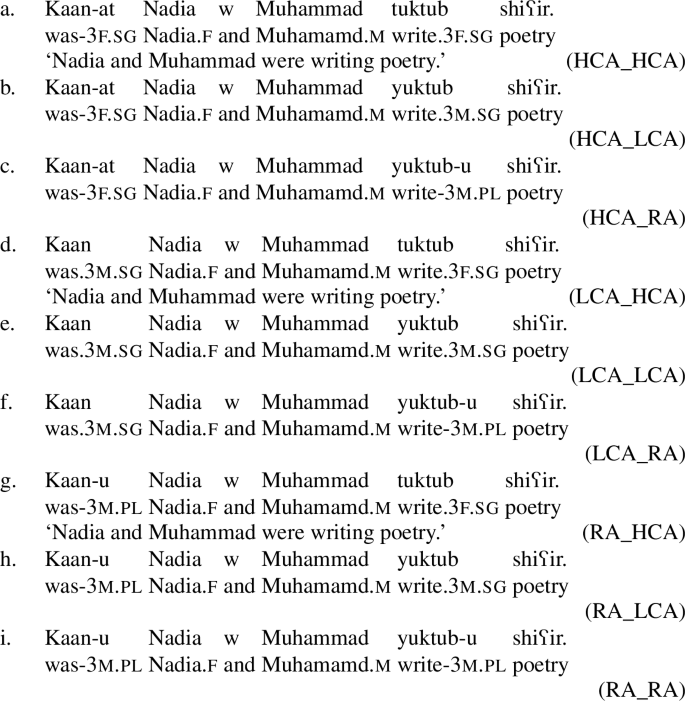
-
(2)
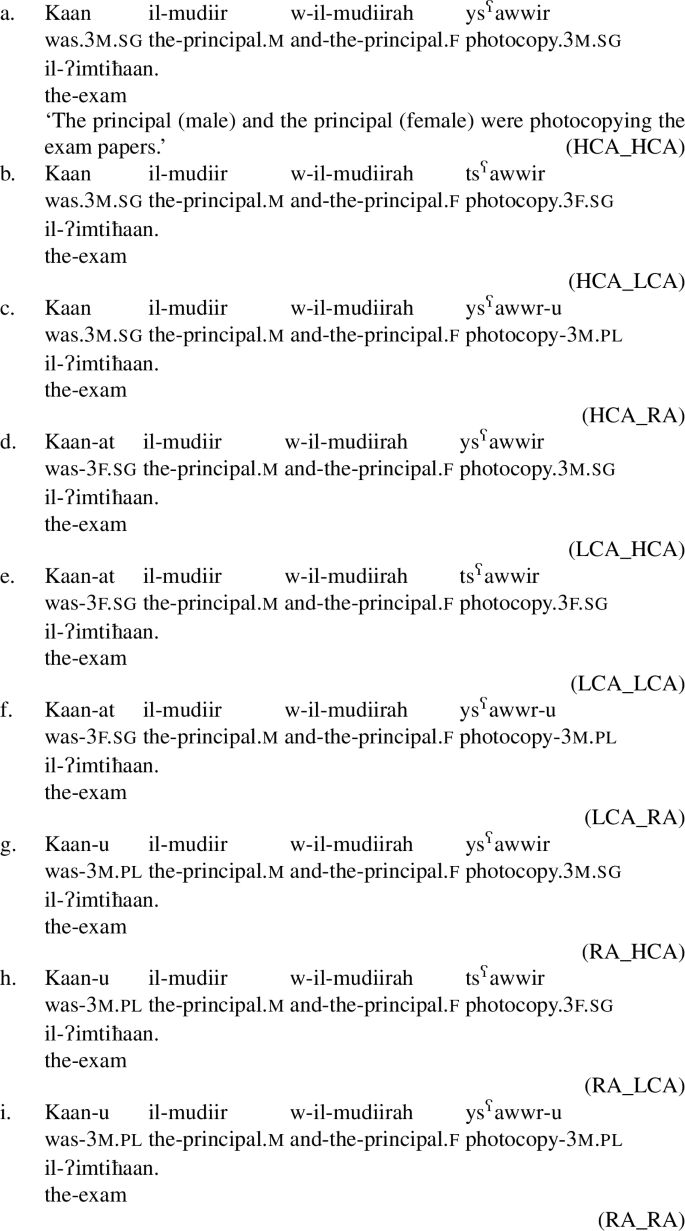
-
(3)
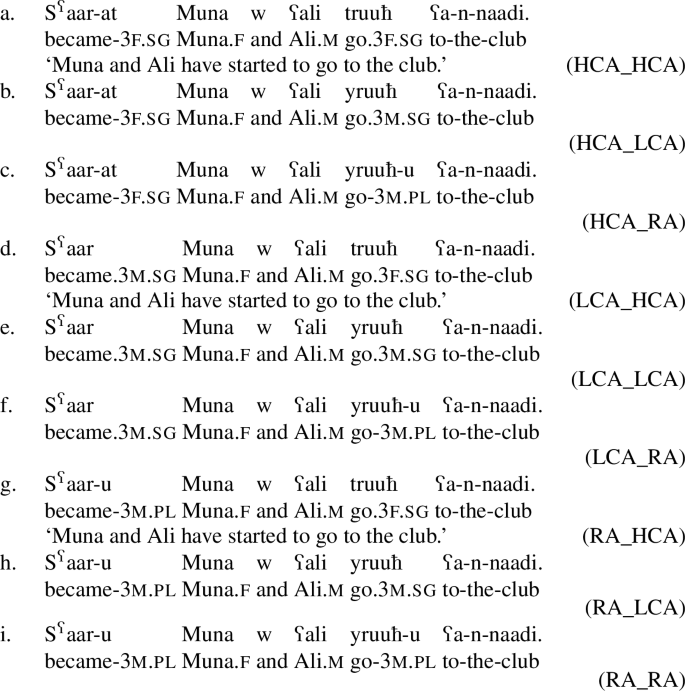
-
(4)
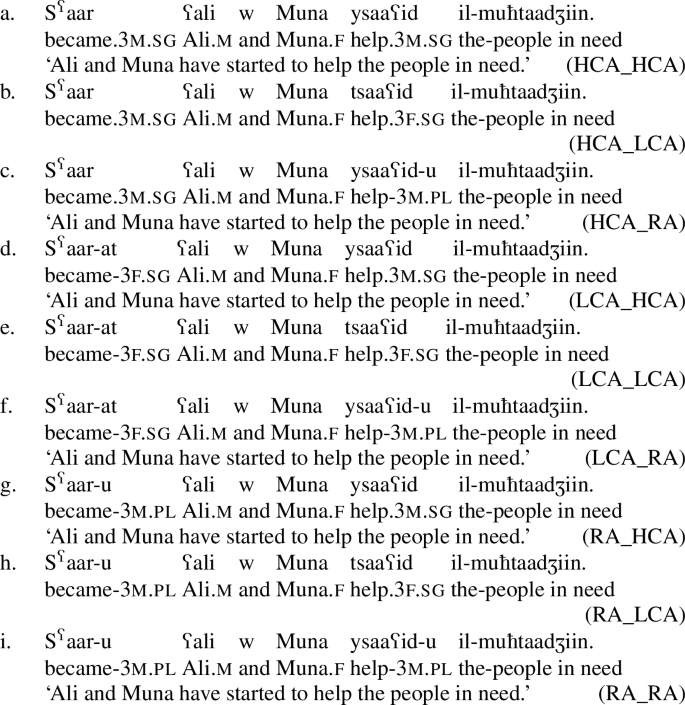
Appendix 2: Test items of Experiment 2
-
(1)

-
(2)

-
(3)

-
(4)

Appendix 3: Test items of Experiment 3
-
(1)

-
(2)
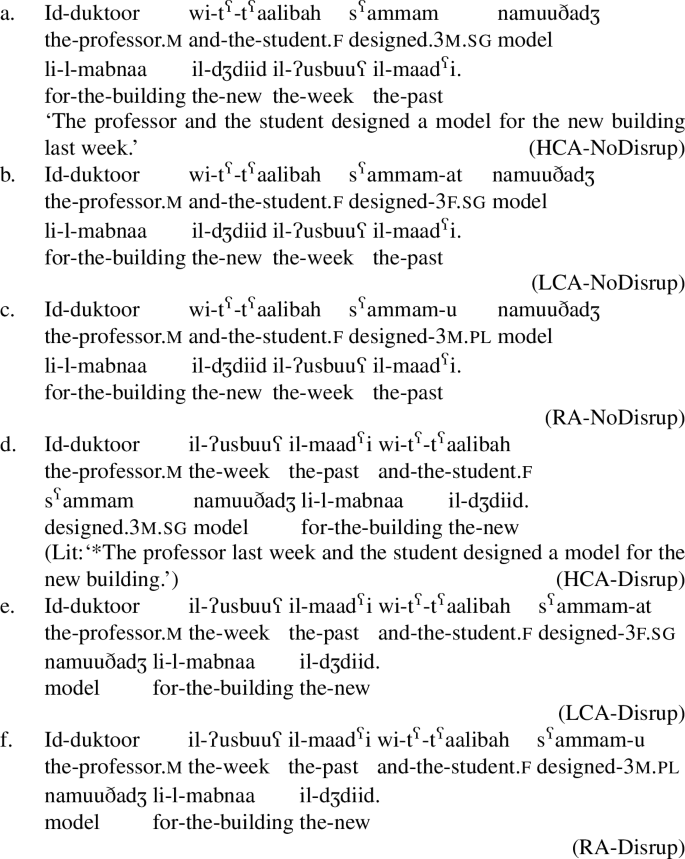
-
(3)
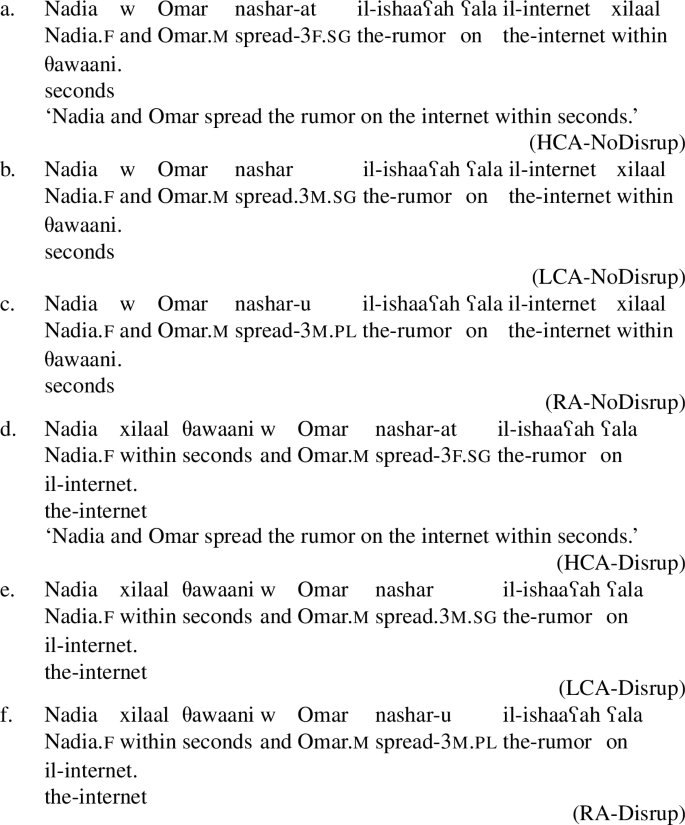
-
(4)
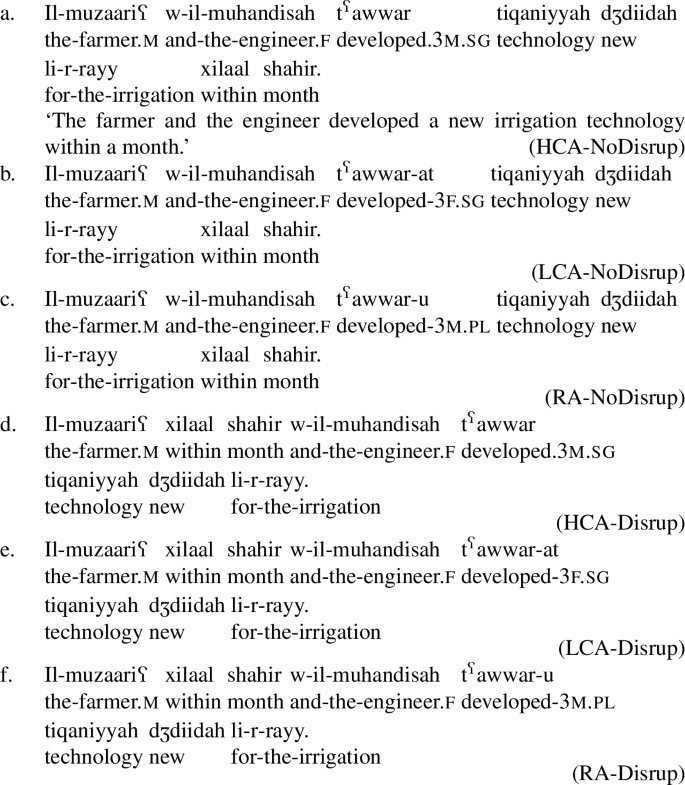
Appendix 4: Test items of Experiment 4
-
(1)
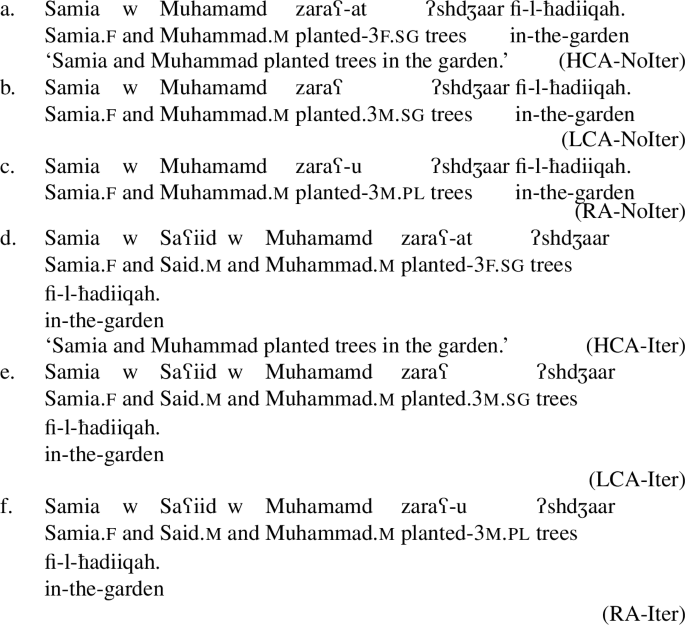
-
(2)
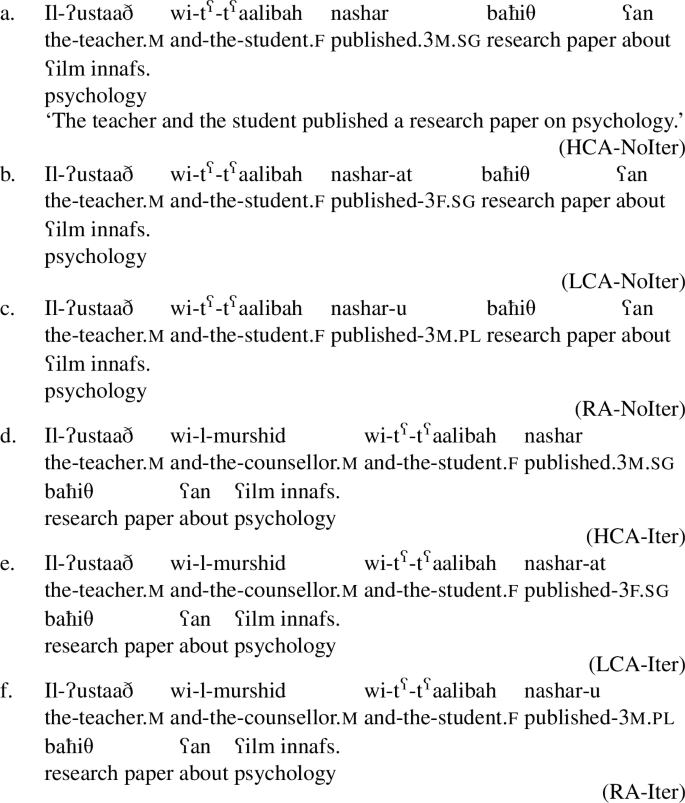
-
(3)
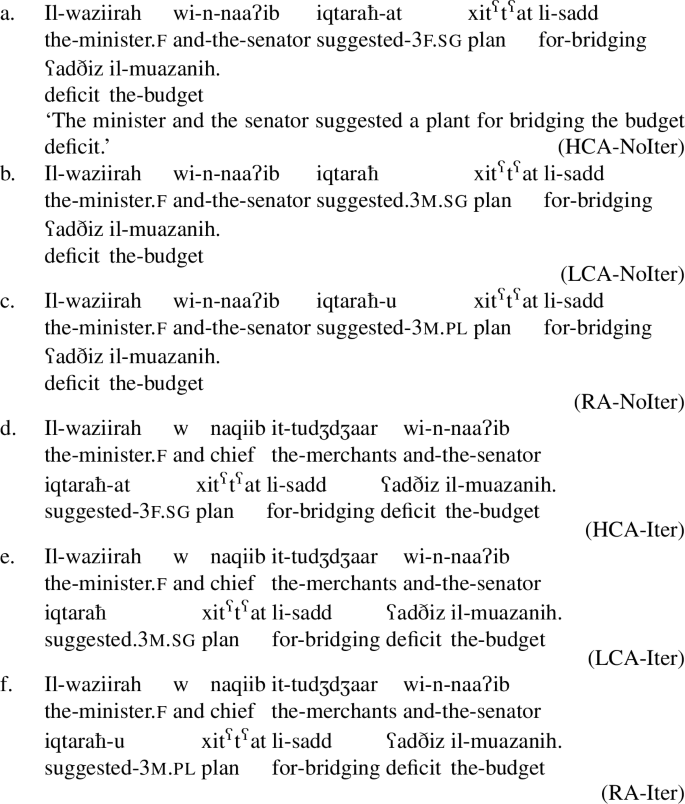
-
(4)

Rights and permissions
About this article
Cite this article
Al Khalaf, E. Furthest conjunct agreement in Jordanian Arabic. Nat Lang Linguist Theory 40, 345–391 (2022). https://doi.org/10.1007/s11049-021-09515-0
Received:
Accepted:
Published:
Issue Date:
DOI: https://doi.org/10.1007/s11049-021-09515-0

